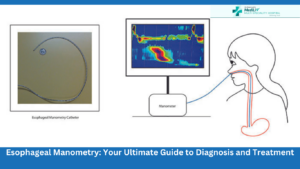Table of Contents
Introduction
Understanding Esophageal Manometry
●What is Esophageal Manometry?
●Why is Esophageal Manometry Done?
The Procedure
●Preparing for the Test
●During the Test
●After the Test
Interpreting the Results
Treatment Options
●Lifestyle Changes
●Medications
●Surgical Interventions
Expert Insights – Dr. Sharad Deshmukh
Mediliv Hospital’s Approach
FAQs about Esophageal Manometry
Conclusion
Introduction
When it comes to understanding and addressing digestive health issues, medical advancements have paved the way for sophisticated diagnostic techniques. One such procedure that has revolutionized the diagnosis and treatment of esophageal disorders is Esophageal Manometry. In this comprehensive guide, we’ll explore what esophageal manometry is, why it’s done, the procedure itself, how the results are interpreted, treatment options, and insights from the renowned expert, Dr. Sharad Deshmukh, along with a glimpse into the approach of Mediliv Hospital.
Understanding Esophageal Manometry
What is Esophageal Manometry?
Esophageal manometry is a medical procedure used to evaluate the functionality of the esophagus, a muscular tube that carries food and liquids from the mouth to the stomach. This procedure aids in diagnosing various esophageal disorders by measuring the pressure and coordination of the muscles in the esophagus during swallowing.
Why is Esophageal Manometry Done?
Esophageal manometry is performed to diagnose a range of conditions such as gastroesophageal reflux disease (GERD), achalasia, esophageal spasms, and dysphagia (difficulty in swallowing). By measuring the pressure exerted by the esophageal muscles, doctors can pinpoint the root cause of these issues and recommend appropriate treatments.
The Procedure
Preparing for the Test
Before undergoing esophageal manometry, your doctor will provide you with specific instructions. These include fasting for a 5 to 7-hour period, avoiding medications that could interfere with the test, and discussing any allergies you might have.

During the Test
During the procedure, a thin, flexible tube (catheter) with sensors is inserted through your nose and into your esophagus. This catheter measures the muscle contractions and pressures as you swallow. The data collected is then transmitted to a computer for analysis.
After the Test
Once the test is complete, the catheter will be removed. You can usually resume your daily activities immediately. Your doctor will carefully review the data collected to interpret the results accurately.
Interpreting the Results
The data obtained from esophageal manometry provides valuable insights into the function of your esophagus. Abnormal pressure patterns or coordination issues can help diagnose specific conditions. Your doctor will explain the results to you and discuss the appropriate next steps.
Treatment Options
Lifestyle Changes
For certain conditions like GERD, lifestyle modifications can play a significant role. These changes may include adjusting your diet, maintaining a healthy weight, and avoiding trigger foods.
Medications
Medications can be prescribed to alleviate symptoms and manage esophageal disorders. Acid reflux medications, muscle relaxants, and pain relievers are some examples, depending on the diagnosed condition.
Surgical Interventions
In cases where conservative treatments don’t suffice, surgical options may be considered. These can range from minimally invasive procedures to more complex surgeries, all aimed at improving esophageal function.
Expert Insights – Dr. Sharad Deshmukh
To shed light on the importance of esophageal manometry, we reached out to Dr. Sharad Deshmukh, a distinguished expert in gastroenterology. Dr. Deshmukh emphasizes, “Esophageal manometry has revolutionized our ability to diagnose esophageal disorders precisely. This allows us to tailor treatments to individual patients, leading to better outcomes and improved quality of life.”
Mediliv Hospital’s Approach
At Mediliv Hospital, our multidisciplinary team of specialists utilizes cutting-edge technology to perform esophageal manometry. Driven by our commitment to patient care, we ensure that each individual receives accurate diagnoses and personalized treatment plans for the best possible results.
FAQs about Esophageal Manometry
Q1: Is esophageal manometry a painful procedure? A: While there might be some discomfort during the insertion of the catheter, the procedure is generally well-tolerated and not considered painful.
Q2: How long does the procedure take? A: The procedure usually takes around 30 to 60 minutes to complete.
Q3: Are there any risks associated with esophageal manometry? A: The risks are minimal. However, there might be slight nose irritation and, rarely, nosebleeds after the catheter is removed.
Q4: How soon can I expect the results? A: Your doctor will review and discuss the results with you in a follow-up appointment, usually within a week.
Conclusion
Esophageal manometry stands as a cornerstone in the realm of gastroenterology, enabling precise diagnosis and tailored treatment for various esophageal conditions. With its non-invasive nature and accurate results, this procedure offers patients a path toward improved digestive health and an enhanced quality of life. Remember, if you’re experiencing symptoms related to esophageal disorders, consulting a medical professional is the first step toward finding effective solutions.
